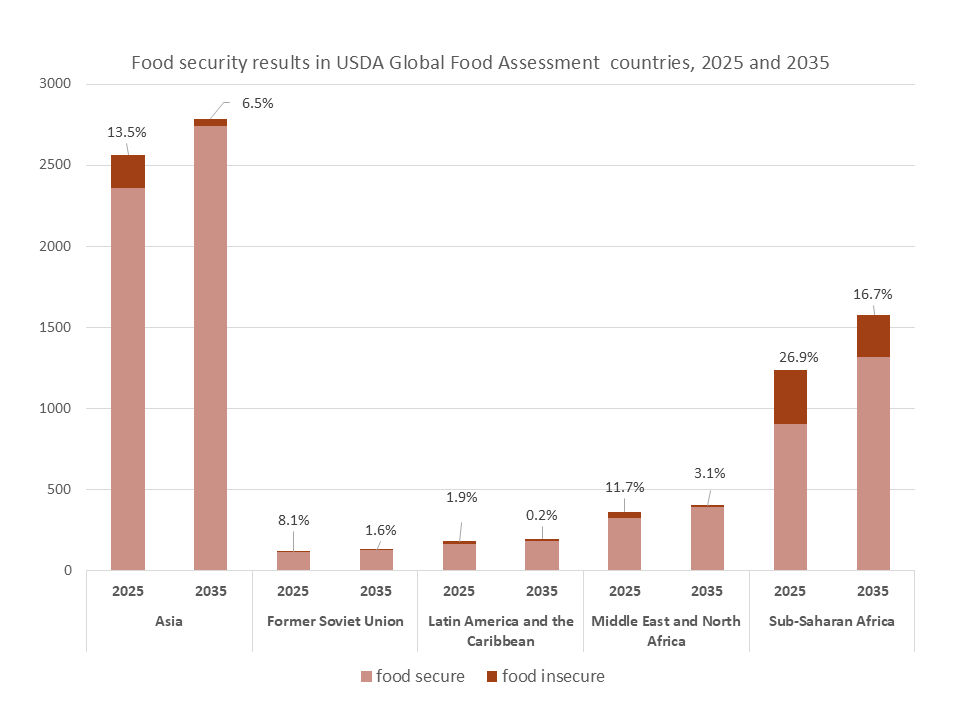Pick Up
1342. Food Security Outlook for Low- and Middle-Income Countries Over the Next 10 Years

1342. Food Security Outlook for Low- and Middle-Income Countries Over the Next 10 Years
The United States Department of Agriculture (USDA) has published a report examining the food security outlook for 83 low- and middle-income countries across five regions: Asia, the former Soviet Union, Latin America and the Caribbean, the Middle East and North Africa, and sub-Saharan Africa, from 2025 to 2035.
The economies of these 83 countries (representing an estimated population of 4.4 billion people in 2025) continue to recover from several global shocks, including food and input price inflation and volatile weather events, that occurred over the past three years. Average gross domestic product (GDP) per capita in these countries is estimated to reach $2,648 (at 2017 prices) in 2025, above the 2022-2024 average of $2,476. This growth, combined with relatively low inflation rates in most of the assessed countries, is expected to result in a significant decrease in food insecurity in 2025 compared to 2024; however, inflation remains a concern for many low-income countries. While food security is projected to improve in most assessed countries over the next decade, food insecurity is expected to persist in some regions.
Key findings from the report include:
• Of the 83 countries surveyed, food security is projected to improve in 2025 compared to 2024, due to an average 3.7% increase in GDP per capita in the majority of countries, while international and domestic food prices for most commodities, such as vegetable oils, wheat, and maize, are expected to fall. An estimated 13.5% of the population (604.2 million people) still do not have access to the 2,100 kcal per day needed for a healthy, active lifestyle, which represents a 26.7% decrease compared to 2024 (220.5 million fewer food-insecure people).
• Food security is projected to worsen in 11 countries: Cape Verde, Djibouti, Haiti, Lesotho, Malawi, Nigeria, Sudan, South Sudan, Yemen, Zambia, and Zimbabwe. This deterioration in food security is due to several factors. Lesotho, Malawi, Zambia, and Zimbabwe are expected to experience maize production shortfalls due to drought in 2024. Zimbabwe continues to experience macroeconomic instability and high inflation, Nigeria experiences slowing economic growth, armed conflict, and floods; and Sudan and South Sudan continue to experience conflict and high inflation. Djibouti is experiencing weather-related shocks and trade disruptions. Yemen continues to experience conflict, drought, and high inflation, and Haiti continues to experience violent conflict.
• Sub-Saharan Africa is projected to have the highest number (332.3 million) and proportion (26.9%) of food-insecure people in 2025.
• Food security in the selected countries is projected to improve significantly by 2035, with 332.9 million people projected to be food insecure, a 44.9% decrease from 2025. The proportion of the population consuming less than 2,100 kcal per day is projected to decline to 6.5% by 2035 (down 51.7% from 2025), driven by projected growth in GDP per capita, particularly in the former Soviet Union, South Asia, and Southeast Asia, with the relative decline in international commodity prices also contributing to this trend.
• The food gap (defined as the amount of food needed to reach the 2,100 kcal daily calorie threshold for all food-insecure people) reflects the severity of food insecurity. It is calculated by weighting the estimated food gap and the number of food-insecure people in each country or region. Across the 83 GFA countries, the average daily calorie food gap is projected to increase slightly from 353 kcal in 2025 to 362 kcal in 2035 (a 2.6% increase). This increase is primarily due to the concentration of food-insecure people in severely food-insecure countries and regions by 2035, such as sub-Saharan Africa and the Caribbean, particularly Haiti.
• Total cereal demand across the 83 countries is projected to grow by 2.2% annually over the next decade, reaching 1.4 billion tonnes by 2035. This growth is driven by rising per capita income (mainly in Asia and the former Soviet Union) and population growth (particularly in sub-Saharan Africa). However, cereal production in these countries is projected to grow by only 1.6% annually, resulting in significant food and feed supply shortages, particularly in Asia and sub-Saharan Africa.
(Reference)
Zereyesus, Y. A., Cardell, L., Farris, J., Ajewole, K., Johnson, M. E., Lin, J., Valdes, C., & Zeng, W. (2025). Global food assessment, 2025–35 (Report No. GFA-36). U.S. Department of Agriculture,Economic Research Service. https://ers.usda.gov/sites/default/files/_laserfiche/publications/11329…
Contributor: IIYAMA Miyuki, Information Program
